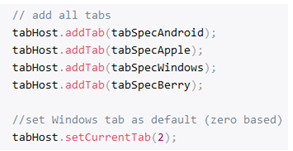
Lesson Plan: Unit - 04
Subject: P15A2AAD - Android Application Development
Topic of Study: Using Built-in View Container Classes
Grade/Level: Master of Computer Applications
Objective: To demonstrate different built-in View Container Classes
Time Allotment: 55 Minutes
- Using Built-in View Container Classes
- Layouts are not the only controls that can contain other View objects.
- These View objects encapsulate other, simpler View types and give the user some interactive ability to browse the child View objects in a standard fashion.
- The types of ViewGroup containers built-in to the Android SDK framework include
- Lists, grids, and galleries
- Switchers with ViewFlipper, ImageSwitcher, and TextSwitcher
- Tabs with TabHost and TabControl
- Scrolling with ScrollView and HorizontalScrollView
- Hiding and showing content with the SlidingDrawer
- Using Data-Driven Containers:
- Some of the View container controls are designed for displaying repetitive View objects in a particular way.
- Exa.
- ListView: Contains a vertically scrolling, horizontally filled list of View objects, each of which typically contains a row of data; the user can choose an item to perform some action upon.
- GridView: Contains a grid of View objects, with a specific number of columns; this container is often used with image icons; the user can choose an item to perform some action upon.
- GalleryView: Contains a horizontally scrolling list of View objects, also often used with image icons; the user can select an item to perform some action upon.
- Adapter View:
- These containers are all types of AdapterView controls.
- An AdapterView control contains a set of child View controls to display data from some data source.
- An Adapter generates these child View controls from a data source.
- An Adapter reads data from some data source and provides a View object based on some rules, depending on the type of Adapter used.
- Types of Adapter:
- Adapter classes are the CursorAdapter and the ArrayAdapter.
- The CursorAdapter gathers data from a Cursor, whereas the ArrayAdapter gathers data from an array.
- A CursorAdapter is a good choice to use when using data from a database.
- The ArrayAdapter is a good choice to use when there is only a single column of data or when the data comes from a resource array.
- Exa. of Design
- Exa. of Output
- Step 01 : Demo of List View
- Step 02 : Demo of List View
- Using List Activity:
- The ListView control is commonly used for full-screen menus or lists of items from which a user selects.
- As such, you might consider using ListActivity as the base class for such screens.
- Using the ListActivity can simplify these types of screens.
- First, to handle item events, you now need to provide an implementation in your ListActivity.
- For instance, the equivalent of onListItemClickListener is to implement the onListItemClick() method within your ListActivity
- Second, to assign an Adapter, you need a call to the setListAdapter() method.
- Exa. of Design
- Exa. of Output
- Step 01: Demo of List Activity
- Step 02: Demo of List Activity
- Step 03: Demo of List Activity
- Organizing Screens with Tabs:
- The Android SDK has a flexible way to provide a tab interface to the user.
- Much like ListView and ListActivity.
- There are two ways to create tabbing on the Android platform.
- You can either use the TabActivity, which simplifies a screen with tabs, or you can create your own tabbed screens from scratch.
- Both methods rely on the TabHost control.
- Tab Host:
- Android TabHost provides a nice way to present multiple thing on a Single Screen.
- These things are presented by Tabs.
- In order to use tabs we need to set 2 things to Tab…
- Tab Indicator : Text to show on Tab, done by setIndicator("Tab Name");
- TAB Content: The activity that will be opened when user selects/clicks particular tab, done by setContent(activityObject);
- Exa.
- Step 01 : Select the Project.
- Step 02: Add Tabhost to Activity.
- Step 03: Just drag and drop that you want on tabs. It will create no of tabs as per controls.
- Step 04: Modify in Java file.
- Customized Tabs:
- Step 01: Create Project & Add TabHost control & add id=“@android:id/tabhost” & remove 3 tabs.
- Step 02: extends the activity…
- Exa.
- Step 03: Write a code & create a empty activities…
- Exa.
- Step 04: appends the tab…
- Exa.
- Step 05: Run your code.
- Exploring Other View Containers
- SlidingDrawer:
- This control includes two parts: a handle and a container view.
- The user drags the handle open and the internal contents are shown; then the user can drag the handle shut and the content disappears.
- The SlidingDrawer can be used horizontally or vertically and is always used from within a layout representing the larger screen.
- Exa.
- Step 01: Design in XML
- Step 02: Write Code in .java
- View Switcher:
- In Android, ViewSwitcher is a sub class of ViewAnimator that is used for switching between views.
- It is an element of transition widget which helps us to add transitions on the views.
- It is mainly useful to animate a view on screen.
- ViewSwitcher switches smoothly between two views (i.e. TextView, ImageView or any layout) and thus provides a way of transitioning from one view to another through appropriate animations.
- You can create views for a ViewSwitcher widget either using a factory or by adding them on your own.
- Step 01 : Drag the ViewSwitcher in xml.
- Exa
- Step 02 : write a code in .java file
- Exa.
- Step 02 : write a code in .java file
- Exa.


















